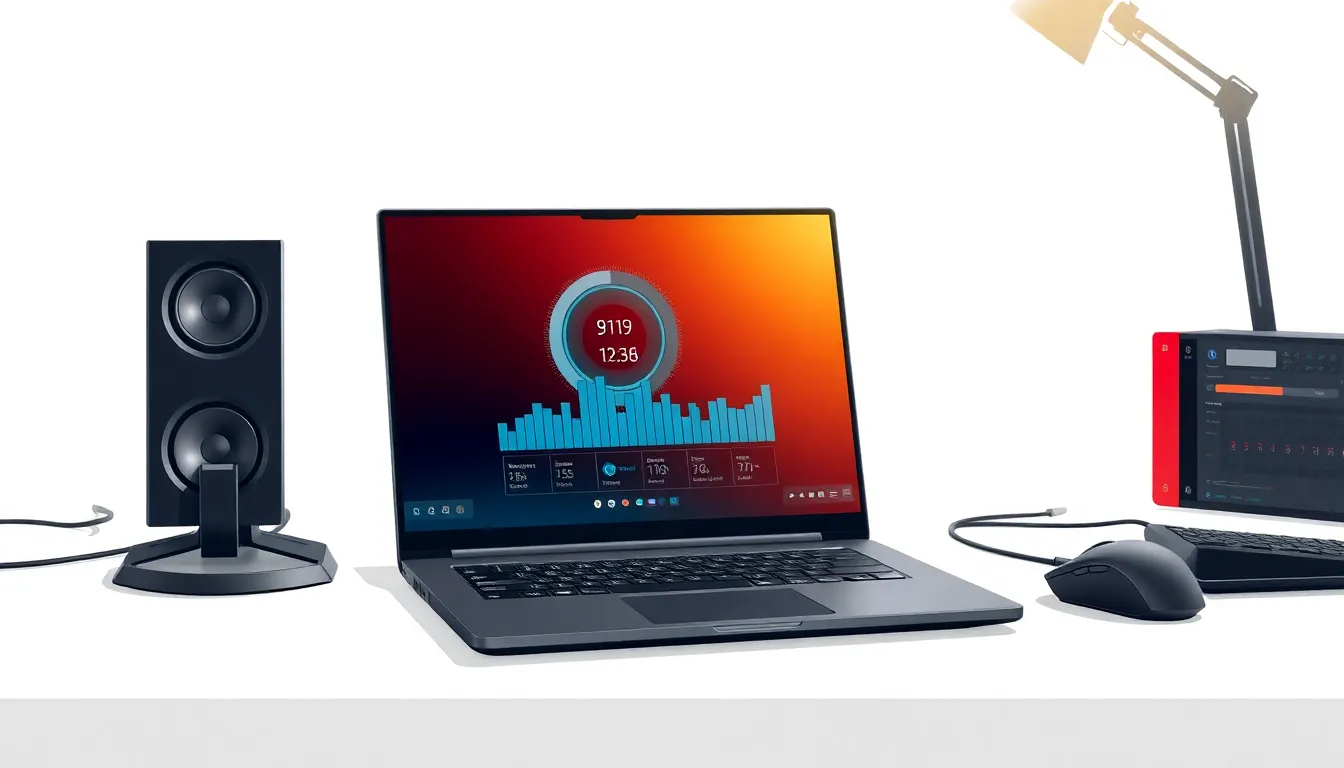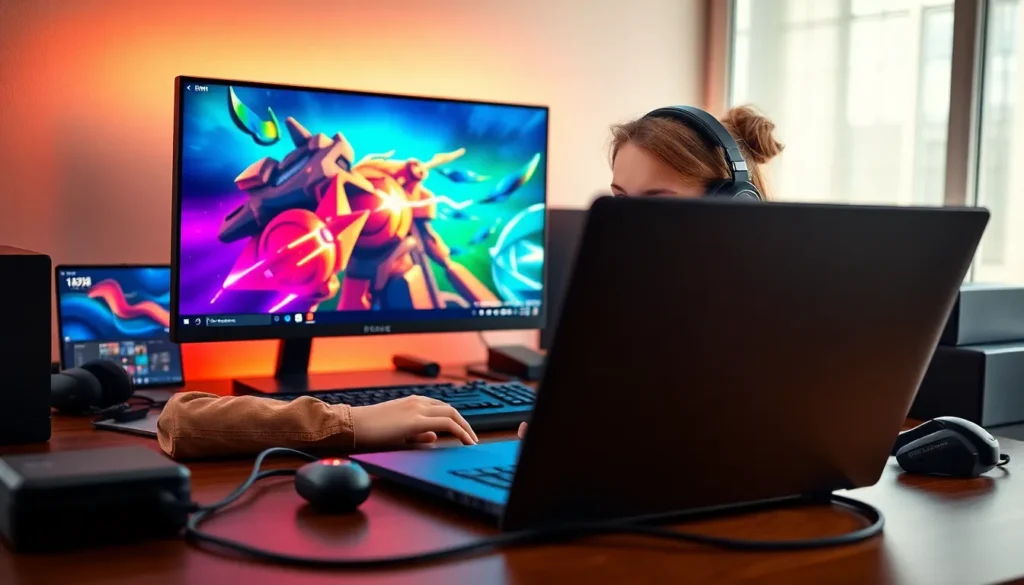Table of Contents
ToggleIn a world where multitasking feels like juggling flaming swords, having a high-performance notebook isn’t just a luxury—it’s a necessity. Whether it’s gaming, graphic design, or simply trying to keep up with a never-ending list of tabs, the right specs can make all the difference. Imagine breezing through demanding tasks while your laptop hums along like a well-oiled machine.
Overview of High-Performance Notebooks
High-performance notebooks serve essential roles in facing demanding tasks. Users require robust specifications to maximize productivity across various applications.
Importance of Specs in Performance
Specifications directly affect a notebook’s overall performance. A powerful processor enables faster execution of complex software, catering to professionals in graphic design and gaming. Sufficient RAM guarantees smooth multitasking, allowing seamless switching between applications. Graphics cards enhance visual rendering, critical for gamers and designers alike. Storage speed impacts load times, with SSDs dramatically improving access to files compared to traditional HDDs. Specific benchmarks can verify performance metrics, helping users choose the right configuration.
Key Features to Consider
While selecting a high-performance notebook, certain features should take precedence. First, processors like Intel Core i7 or AMD Ryzen 7 deliver substantial power for intensive tasks. Second, 16GB RAM or more ensures efficient multitasking capabilities. Additional considerations include dedicated graphics cards, essential for heavy graphics workloads, and high-resolution displays that improve user experience. Long battery life enhances portability, which is crucial for users who work on the go. Finally, reliable cooling systems prevent overheating, maintaining optimal performance during demanding sessions.
Processor Specifications

Choosing the right processor significantly influences a notebook’s performance. High-performance notebooks typically feature advanced processor options that handle demanding tasks efficiently.
Types of Processors
Intel and AMD dominate the market for high-performance processors. Intel Core i7 processors deliver excellent performance for tasks like gaming and graphic design. AMD Ryzen 7 processors offer competitive speeds and multitasking capabilities. Some notebooks may incorporate Intel Core i9 or Ryzen 9 for even greater power. These processors provide additional cores and threads, enhancing parallel processing. Selecting the appropriate type depends on the user’s specific performance needs and budget.
Performance Metrics
Performance metrics provide insights into a processor’s capabilities. Common metrics include clock speed measured in GHz, core count, and thread count. For instance, processors with higher base clock speeds generally execute tasks faster. Benchmarks like Cinebench and PassMark measure performance across various workloads, allowing users to compare different processors. Effective thermal design power (TDP) indicates how much heat a processor generates, influencing cooling requirements. Users should prioritize these metrics based on their application needs, ensuring optimal performance during intensive use.
Graphics Performance
Graphics performance plays a crucial role in determining a notebook’s capability to handle visual-intensive tasks such as gaming and graphic design. Key distinctions exist between integrated and dedicated graphics systems.
Integrated vs. Dedicated Graphics
Integrated graphics share system memory and are suitable for everyday tasks, offering basic performance for casual gaming and productivity. Dedicated graphics, on the other hand, possess their own memory and power, delivering significantly better performance for demanding applications. Users engaged in heavy 3D rendering or advanced gaming benefit from dedicated graphics cards such as NVIDIA GeForce and AMD Radeon options. These dedicated systems handle complex textures, high frame rates, and superior resolution efficiently. While integrated options suffice for basic needs, prioritizing dedicated graphics ensures a smoother experience during intensive tasks.
Graphics Memory Considerations
Graphics memory, known as VRAM, affects a notebook’s ability to store and process visual data quickly. Higher VRAM, ideally 4GB or more, caters to high-resolution displays and demanding software, enhancing the user experience. When selecting a notebook, consider the type of applications in use. Content creators and gamers demand larger VRAM for optimal performance with heavy textures and detailed graphics. Adequate graphics memory prevents bottlenecking, ensuring seamless multitasking during intense sessions. Prioritizing notebooks with sufficient VRAM enables users to maximize visual fidelity and maintain fluid performance across various applications.
RAM and Storage Options
RAM and storage significantly impact high-performance notebook functionality. Choosing the appropriate amount of RAM and understanding storage types directly influences multitasking efficiency and overall system speed.
Importance of RAM Size
Sufficient RAM size is crucial for smooth performance, especially during intensive applications. At least 16GB of RAM is generally recommended for high-performance notebooks. This amount facilitates seamless multitasking, allowing users to run complex software and multiple programs simultaneously without slowdowns. More demanding tasks might benefit from even higher RAM capacities, such as 32GB. Notebooks equipped with ample RAM enhance responsiveness, prevent lag, and boost productivity across various applications. Prioritizing adequate RAM ensures a high-performance notebook can handle modern workloads effectively.
Storage Types and Their Impact
Storage type plays a vital role in a notebook’s performance. Solid-State Drives (SSDs) are preferred due to their significantly faster data access compared to traditional Hard Disk Drives (HDDs). Users experience quicker boot times and reduced loading durations with SSDs, which translates into a smoother overall experience. For high-performance tasks, an NVMe SSD provides superior speed over standard SSDs. Combining SSDs with additional storage options, such as HDDs, can help balance capacity and performance. Prioritizing fast storage solutions maximizes efficiency and reduces delays in accessing files and applications.
Display Specifications
Display specifications play a crucial role in enhancing visual experience and overall productivity. High-performance notebooks often feature advanced displays that cater to demanding tasks.
Resolution and Aspect Ratio
Prioritizing resolution ensures sharp images and clear text. A minimum of Full HD (1920×1080) is essential for most tasks, while 4K (3840×2160) provides exceptional detail for graphic design and gaming. Aspect ratio influences screen space and usability, with the traditional 16:9 being common for media consumption. Some users prefer 16:10 or 3:2 for additional vertical space, improving productivity during multi-window tasks. Select higher resolutions and consider aspect ratios that suit specific workflows for the best performance.
Refresh Rate and Color Accuracy
High refresh rates significantly enhance the visual experience. A refresh rate of at least 60Hz is standard, but 120Hz or higher offers smoother visuals, particularly for gaming. Alongside refresh rates, color accuracy remains paramount. Notebooks with 100% sRGB coverage provide accurate colors for creative work. Some models even boast Adobe RGB or DCI-P3 capabilities, ensuring vibrant and true-to-life colors. Prioritizing refresh rates and color accuracy together allows for better performance in intensive applications.
Battery Life Considerations
Battery life plays a crucial role in the performance of high-performance notebooks. Efficient management of power usage enhances portability and usability during demanding tasks.
Impact of Specs on Battery Performance
Power-hungry components significantly impact battery longevity in high-performance notebooks. Processors like Intel Core i9 and AMD Ryzen 9 consume more power than their lower-tier counterparts, which can lead to quicker battery depletion. Additionally, dedicated graphics cards, while essential for rendering, also draw considerable energy. Higher RAM capacities and faster storage options, such as NVMe SSDs, contribute to power demands. Users might experience varying battery performance based on the balance of these specifications, so optimizing for efficiency is essential.
Tips for Extended Battery Life
Reducing screen brightness can immediately extend battery life. Activating battery saver mode minimizes background activity, ensuring that only essential processes run. Additionally, closing unnecessary applications conserves power and enhances efficiency during multitasking. Opting for energy-efficient graphics settings in games or demanding software also aids battery management. Regular OS updates ensure power management features stay optimized. Prioritizing these strategies can lead to significant improvements in battery performance during essential tasks.
Choosing the right high-performance notebook is crucial for anyone needing to tackle demanding tasks. By focusing on key specifications like powerful processors sufficient RAM and dedicated graphics cards users can significantly boost their productivity. A well-balanced combination of these elements ensures smooth multitasking and efficient performance across various applications.
Additionally the importance of fast storage solutions and high-quality displays cannot be overlooked. With the right notebook users can maximize their efficiency and enjoy a seamless experience whether they’re gaming designing or managing multiple projects. Prioritizing these features will lead to a more satisfying and productive computing experience.







